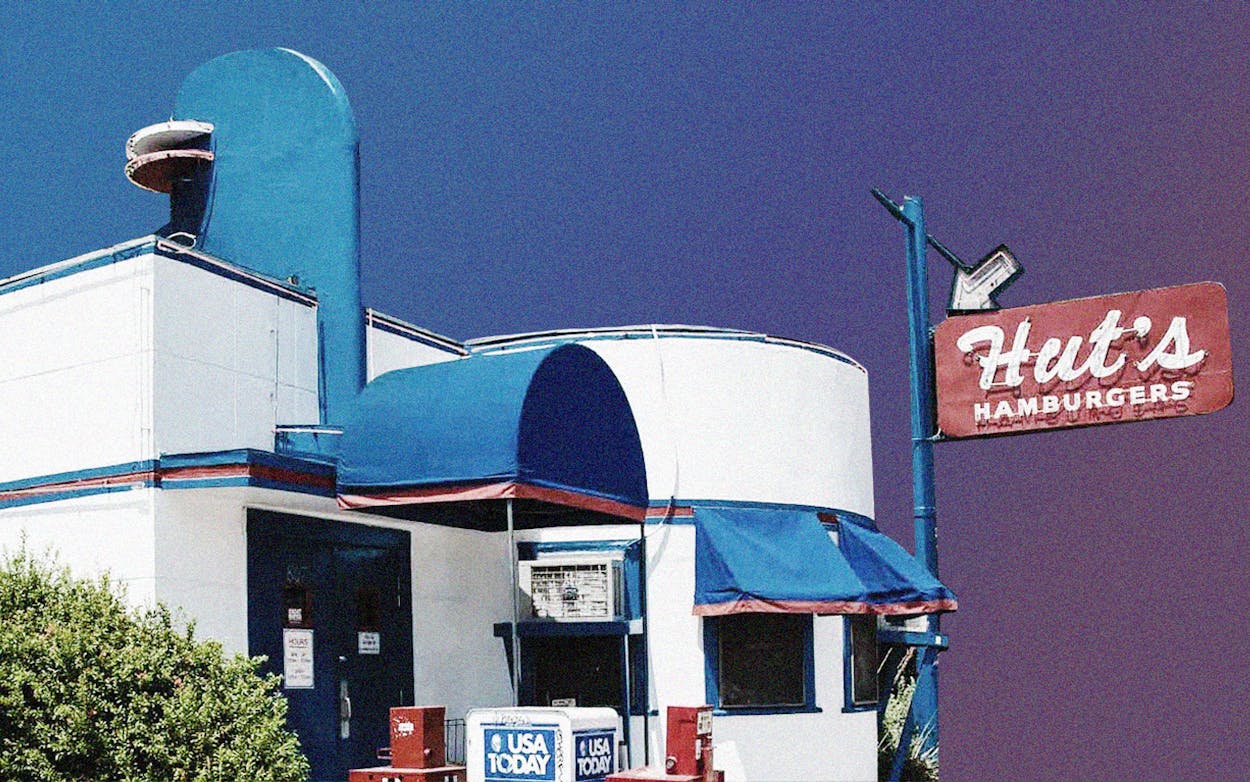Austin’s evolution from a sleepy college town with cheap rent and a slacker ethos to a burgeoning tech hub with pricy real estate and a start-up mentality has been well documented. (Former Texas Monthly staffer Joe Nick Patoski’s Austin to ATX, released earlier this year, might be the definitive look at the subject.)
This transformation is evident on many fronts—including the gentrification of once marginalized and underdeveloped East Austin, the hordes of bachelorette parties that treat the city like an Instagram playground, the ongoing reshaping of the skyline, and (especially noticeable in the last year) the closure of iconic restaurants.
Just this week, Hut’s Hamburgers, in downtown Austin since 1969 (and on South Congress Avenue for three decades before that), announced it’ll close its doors for good in October. Its sister restaurant, downtown pizza joint Frank & Angie’s, already said goodbye last fall, its owners citing an increasing lack of affordability for small businesses in the central business district as one of the driving factors.
Those two are far from the only notable recent casualties of the city’s dining scene. Last July, the Frisco Shop, which opened in 1953 and played a role in Austin’s racial integration, shuttered. Threadgill’s, a legendary shrine to the city’s Waylon & Willie days, folded its location near Lady Bird Lake in December (its original North Austin outpost survives, for now). Suzi’s China Grill closed that same month, as did the rebooted J.T. Youngblood’s Fried Chicken—a revival of a legendary Texas joint from the 1960s.
East Side Cafe, a longtime brunch spot that used herbs and vegetables from its on-site garden, shut down in January. Zocalo, a less storied taco spot that nonetheless helped define casual dining in the Clarksville neighborhood during its twelve-year run, closed in March. Austin Java, a full-menu cafe that had three central Austin locations for years, is down to just one in the city’s core (the company has focused on expanding outside of the heart of the city). The UT campus-area location of Conan’s Pizza, where countless students enjoyed thick, bready pizzas since 1976, slung its last ‘za last summer, though its north and south locations remain.
Hut’s won’t be the last holdover from Austin’s “slacker” days to say its goodbyes. In a city whose population is growing rapidly, the fact that a place was a hot spot decades ago matters less—especially as newcomers crowd the restaurant scene and rocketing property values beget rents and taxes that are difficult to afford.
“Iconic” status doesn’t protect restaurants from facing the same forces that have so rapidly remade sizable swaths of the city. John Silberberg, owner of longtime Austin mainstay Mother’s Cafe, told Community Impact earlier this month that he’s banking on sticking to the restaurant’s old-school aesthetic as a way to differentiate it from the host of hipper competition that’s arrived with Austin’s boom: “I read a Yelp review a few years ago, and it essentially said, ‘Yeah, I enjoyed [Mother’s]. It just seemed like a vegetarian restaurant from the ‘80s,'” he told the paper. “That’s exactly right, exactly what we are.”
Sticking to the formula has worked out for others—the Omelettery, which lost the lease on its original location on Burnet Road in 2015, moved a few miles away to a larger spot in a strip mall on Airport Boulevard and saw its wait times spike as locals rallied to ensure it was a success. But other well-known Austin eateries have survived by evolving with the times—like Kerbey Lane Cafe, which established itself in 1980 as a 24-hour spot mostly for college students, but has updated its concept for the version of Austin it operates eight restaurants in now. (In April, the company introduced a new “clean eating” menu that includes vegan queso and bone broth.)
There are a lot of reasons that restaurants fail—rising rents, bad marketing, financial mismanagement—but in Austin right now, even folks who knew how to keep a place thriving for decades are finding business more difficult than ever. The city will continue on just fine without Hut’s, Frank & Angie’s, East Side Cafe, the Frisco, and whatever other landmark follows them into oblivion. (And, it should be noted, the overall quality and diversity of offerings among the city’s restaurants are far greater now than in earlier eras.) Collectively, though, the loss of a host of iconic restaurants serves as yet another reminder that one downside of a booming city is that it often becomes harder and harder for those who’ve loved it all along to recognize.
- More About:
- Austin








